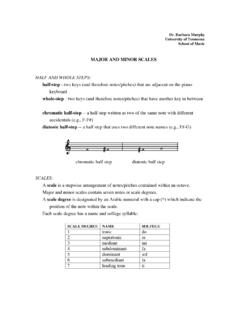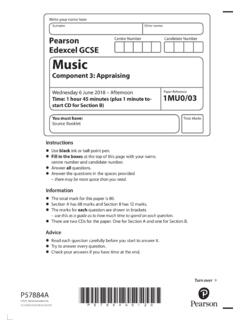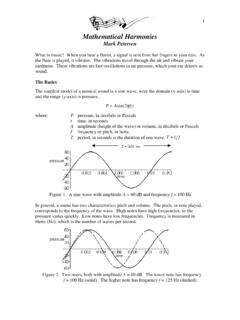Transcription of Jazz Piano Basics Handout WIBC17 - Bandworld
1 JAZZ Piano Basics - DAN DAVEYJAZZ Piano BASICSDAN DAVEYJAZZ Piano Basics - DAN DAVEYYour pianists need YOUR help in rehearsal! Don t expect private teachers to give them everything they need to be successful in YOUR ensemble on YOUR timeline. You need to have an understanding of the role of the Piano and how to communicate voicings, comping, style, and more! Joining the jazz band as a pianist (or any other rhythm section instrument) is much different than joining as a horn player. The concert band notes look shockingly similar to the jazz band notes on the page. The horn player has to learn style and listening responsibilities. The music you hand your pianist looks entirely different and can be very overwhelming unless you know how to help them. Chord tones are numbered based on an 8-note scale using scale degrees 1 (Root), 3, 5, & 7. The following formulas are used to modify a major scale/arpeggio. Basic Symbols: Major 7th: 1 3 5 7 Cmaj7, Cma7, CM7, C 7 Dominant 7th: 1 3 5 b7 C7 minor 7th: 1 b3 5 b7 Cmin7, Cmi7, Cm7, C-7 Half-Diminished: 1 b3 b5 b7 C 7, C , Cmin7(b5), Cmi7(b5), Cm7(b5), C-7(b5), C-7(-5) Diminished 7th: 1 b3 b5 bb7 Co7 minor -major 7th: 1 b3 5 7 Cmin(maj7), C-( 7) See the pattern of how each chord adds one flat to create the next.
2 LEAD YOUR PIANIST ACROSS THE THRESHOLDBASIC FOUR-NOTE CHORD SYMBOLSC 7C7C 7C 7(b5)44&wwwwwwwwbwwwwbbwwwwbbbC 7C7C 7C 7(b5)44&wwwwwwwwbwwwwbbwwwwbbb7 5 3 Rootb7 5 3 Rootb7 5 b3 Rootb7 b5 b3 Root(Same as half-diminished chord)Note: All of this may be applied to your guitarist as well!JAZZ Piano Basics - DAN DAVEYT ensions are non chord tones that are added to a chord to change the color/texture of the chord. Note that scale degrees 10 is the same as 3, 12 the same as 5, 14 the same as 7, and 15 the same as and Root. All of these are Chord Tones (CT), and therefore, these are not tensions. The most common tensions are 9, 11, and 13, or some form of these. Rule of Thumb: There must be a whole step above the 3rd of a chord, so an 11 may become a #11 on major and dominant chords. A half step above the 3rd of the chord confuses the sound of the chord. On a major or dominant chord, raise the 11 so there is a whole step above the 3rd.
3 On a minor chord, the 11 is a whole step above the 3rd WHAT ARE TENSIONS/EXTENSIONS?Chord tones are numbered within the scale Ex: 1, 3, 5, 744& Tensions are numbered outside of the scale even though they may be played/written in any octave. Ex: 9, 11, 13 1 2 3 4 5 6 7 8 9 10 11 12 13 14 15 NUMBERING CHORD TONE EXTENSIONSNUMBERING COMMON TENSIONS/EXTENSIONS44& CTCTCTCTCTCTCTCTCTTHE 11 VS. #1144& #24& b JAZZ Piano Basics - DAN DAVEYC hords with tensions use the basic four-note chord as the foundation. Young players may simply play the basic four-note chords until tensions are introduced to them. Ex: C9 is really a C7 with an added 9. Young musicians can simply play a C7 until tensions are introduced. Guide Tones are the 3rd and the 7th of any chord. These two notes give us information on the quality of the chord The 3rd tells us if it is a major or minor chord The 7th tells us if it s a major seventh or a dominant seventh Cmaj7 vs.
4 C7 - difference is the 7th C7 vs. Cm7 - difference is the 3rd As a pianist (or guitarist), playing the guide tones gives all of the harmonic information needed to Play in a big band rhythm section; Begin reading chord changes; Play fast-moving changes CHORD SYMBOLS WITH TENSIONSGUIDE TONES: THE FOUNDATION OF EVERY CHORDC 7C7C 7C 7(b5)44&wwwwwwwwbwwwwbbwwwwbbb7 3 7 3 C 7C7C 7C 7(b5)44&wwwwwwwwbwwwwbbwwwwbbb7 3 7 3 44&C7( 9)wwwwwbJAZZ Piano Basics - DAN DAVEY Usually, the guide tones resolve within a step to the next chord. The 3rd of one chord becomes the 7th of the next, etc. Range of Voicing: D below middle C up to A above middle C When these voicings are performed, it s important that the pianist learn them in both hands so they can be used for comping behind another soloist, comping behind their own solo, or playing a melody in the right hand. Omit the root of the chord and have students double the voicings in both hands.
5 Adding one note to our guide tone voicings creates a more rich and colorful sound. We add the 9 (or any alterations: b9, #9, etc.) and the 5th (or a substitute of 13, b13, b5, etc.) The pianist learn these voicings in both hands as well so they can be used for comping behind another soloist, comping behind their own solo, or playing a melody in the right hand. Range of Voicing: D below middle C up to C# one octave above middle C Mark Davis Guideline: For voicings with the 3rd on the bottom followed by the 7th, add the 9th on top (options of #9 and b9 for dominant chords). For a 4th note, add the 5th above. For voicings with the 7th on the bottom followed by the 3rd, add the 5th on top (options of 13 or b13 on dominant chords). For a 4th note, add the 9th (options of b9 and #9 on dominant chords). To add another dimension to these voicings, the pianist may play one chord tone or tension in octaves in the right hand.
6 This technique is helpful in cutting through a big band! GUIDE TONE VOICINGS PLUS ONE{C 74444& ?www{C 74444&?wwww9 7 3 7 3 5 9 {PianoC 7C 74444&? wwwwwww5 3 7 3 7 9 5 {{{{Copyright 2017 PianoE 7A7D 7D 7G7C 7C 7F7B 7E 7A 7A 7D 7G 7F 7B7E 7A 7D 7C 7F 7B 7B 7E7A 7D7G 7G 7C7F 7F 7B 7E 7194444&Form A1: 7th on bottom with 3rd aboveGuide Tone VoicingsDan DaveyMt. Hood Community CollegeII - V - I in Cycle 5?& ?##&Form A2: ?& ?bbb #ww## ww bb ww w w wb bb ww bb wwb b bwb b bwb #www bb ww #ww## #ww## b bwb # #w w #ww# b ww w w b www{{{{ 7E7A 7A 7D7G 7G 7C7F 7B 7E 7E 7A 7D 7C 7F 7B 7E 7A 7A 7D 7G 7F 7B7E 7A7D 7D 7G7C 7C 7F7B 743&Form B1: 3rd on bottom with 7th above?& ?##&Form B2: ?& ? #ww## #ww# b ww w w w bb ww bb ww bwb b bwb # www## bb ww bb wwb #ww## b bwb b bwb # w #ww## ww w w bb wbww2{{{PianoF7B 7F7C794444&bGuide Your Tone BluesDan DaveyMt.}}}}}}}}}}}}}}
7 Hood Community College?b&b?b&b?bwwbwwbwwbwwbwwwwwwbwwbw wbwwnwwwwwwwwbwwbwwwwww{{{{Copyright 2017 PianoE 7A7D 7D 7G7C 7C 7F7B 7E 7A 7A 7D 7G 7F 7B7E 7A 7D 7C 7F 7B 7B 7E7A 7D7G 7G 7C7F 7F 7B 7E 7194444&Form A1: Guide Tone Voicings Plus OneDan DaveyMt. Hood Community CollegeII - V - I in Cycle 5?& ?####&Form A2: ?& ?bbbb #www## www bb www w w wb bb wwwb bbb wwwbb b bwb b bwb #wwww bbb wwwb # #www### # #www## b bwb # #w w #www# b www w w b wwww{{{{ 7E7A 7A 7D7G 7G 7C7F 7B 7E 7E 7A 7D 7C 7F 7B 7E 7A 7A 7D 7G 7F 7B7E 7A7D 7D 7G7C 7C 7F7B 743&Form B1: ?& ?##&Form B2: ?& ? # #www## #www# b www n w w w bb www bb wwwb bwb b bwb # # wwww### bb wwwb bbb wwwbb #n #www### b bwb b bwb # w # #www## www w w bb wbwww2{{{PianoF7B 7F7C794444&bGuide Your Tone BluesDan DaveyMt.}}}}}}}}}}}
8 Hood Community College?b&b?b&b?bwwwbwwwbwwwbwwwbwwwwwww bwwwbwwwbwwwnwwwwwwwwwwbwwwbwwwwwww{{{Pi anoF7B 7F7C794444&bDan DaveyMt. Hood Community CollegeGuide Your Tone Blues?b&b?b&b?bwwwwwwwwwwwbwwwbwwwbwwwbw wwwwwwwwwwbwwwbwwwbwwwnwwwwwwwwwwwwwwbww wbwww{{{{Copyright 2017 PianoE 7(b5)A7(b9)D 7D 7(b5)G7(b9)C 7C 7(b5)F7(b9)B 7(b5)E 7(b9)A 7G 7(b5)C 7(b9)F 7F 7(b5)B7(b9)E 7(b5)B 7 E 7E 7(b5)A 7 D 7C 7(b5)F 7 B 7(b5)E7 A 7A 7(b5)D7 G 7G 7(b5)C7 F 7194444&Form A1: Four-Note minor VoicingsDan DaveyMt. Hood Community CollegeII - V - I in Cycle 5?&?###&Form A2: ?&? b #wwww b bwwwwbb bbb bwwwwbb w w wb bbbb bwwwwbbbb ## nwwww## b bwb # #w# #wwwww bb bwwwwbbb bbb nwwwwbbb # #wwww## n bwb b bwb # #w #wwww b bbwwwwb bb bwwwwbb w w w{{{{ 7(b5)E7 A 7A 7(b5)D7 G 7G 7(b5)C7 F 7(b5)B 7 E 7E 7(b5)A 7 D 7C 7(b5)F 7 B 7(b5)F7 B 7B 7(b5)E 7 A 7G 7(b5)C 7 F 7(b5)B7 E 7E 7(b5)A7 D 7D 7(b5)G7 C 743&Form B1:?}}}}}}}}}}}
9 &?&Form B2:?&? #wwww b b#wwwwb bb bwwwwbb w w w bbb bwwwwbbb bbb bwwwwbbbb # #wwww## bwb b bwb # #w bbb bwwwwbb bbbb bwwwwbbbb ## #wwww## wb b bwb # #w# # #wwww# b #wwww b bwwwwbb # w w w2 JAZZ Piano Basics - DAN DAVEY Compliment or Accompany The goal is to provide a harmonic and rhythmic counterpart that creatively supports the other instrumentalists. The pianist helps to create the foundational groove for the band. Comping patterns should represent the subdivision of the groove (triplets, swung/straight 8th notes, etc.) like a drum fill Generally, all notes of the chord should sound together unless rolling/arpeggiating a chord in a ballad, etc. The swing groove is established by a triplet subdivision. LA is the lift where the syncopation occurs.
10 The bass player and comping instruments thrive on the lift! Straight/Even 8th note subdivision Comping patterns should be short and percussive Afro-Cuban grooves should revolve around the 2-3 or 3-2 Son Clave COMPING 101 STYLISTIC CONSIDERATIONS: SWINGDon-LA-Don-LA-Don-LA-Don-LA-Do(n)-L A-Do(n)-LA-Do(n)-LA-Do(n)-LA-Do(n)LADo(n )LADo(n)LADo(n)LADo(n)LADo(n)LADo(n)LADo (n)LA344&33333333&3333 j j j j STYLISTIC CONSIDERATIONS: LATIN44&2-3 Clave3-2 Clave j j JAZZ Piano Basics - DAN long, sustained chords same/similar rhythms to another section/instrument in the holes/spaces a combination of 1-3 (*this is comping!) Listen and groove with the bass and ride/hi-hat Communicate with soloists (requires listening!) Support the band and fill holes where appropriate Not letting the harmonic accompaniment become muddy or heavy! .. especially when other comping instruments are concerned Not all comping instruments can talk at the same time without yielding to each other - jazz is a conversation!










